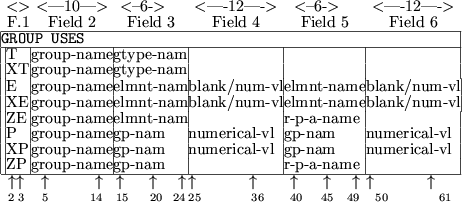 |
The GROUP USES indicator card is used to announce which of the nonlinear elements appear in each group and the type of group function involved. The group types may be selected from among those defined in the GROUP TYPE section of the data while the elements may be selected from among the types defined in the ELEMENT USES section. In addition, group parameter values are assigned. The syntax for data following this indicator card is given in Figure 3.19.
There are three sorts of data cards in the GROUP USES section. For cards of the second and third kinds, the string group-name in data field 2 gives the name, or an array of names, of the group(s) (or row(s) or constraint(s)) under consideration. The name may be up to ten characters long and must have been defined in the GROUPS/ROWS/CONSTRAINTS section.
On array cards (those prefixed by X or Z), the expanded element array name in field 2 must be valid and the integer indices must have been defined in a parameter assignment (see Section 3.2.3).
The first kind of cards, identified by the characters T or XT in field 1, give the name, or an array of names, of a group function and its type. On such cards, the string $$$$$$$$$$ in field 2 is used for two purposes.
The second kind of data card, identified by the characters E, XE or ZE in field 1, is an indication that particular nonlinear elements a re to be included in a given group. Optionally the given elements may be multiplied by specified weights. On these data cards, the string elmnt-name in data fields 3 (and optionally 5 on E and XE cards) hold the names of nonlinear elements to be used. The names in both fields may be up to ten characters long and must have been defined in the ELEMENT USES section. On XE and ZE cards, the names of the nonlinear elements must be components of an array of nonlinear elements, with a valid name and index. The elements are multiplied by given weights. By default, each weight takes the value 1.0. Only non-unit weights need to be specified explicitly. On E and XE cards, the weights are assigned the numerical values specified in data fields 4 (and optionally 6). These values may occupy up to 12 locations of their specified field. The default value of 1.0 is taken whenever these fields are empty. On ZE cards, the string r-p-a-name in data field 5 gives a real parameter array name. This name must have been previously defined and its associated value then gives the numerical value of the weight. Any group that is not named on an E or XE card is taken to have no nonlinear elements.
The last kind of data card, identified by the characters P, XP or ZP in field 1, is used to assign numerical values to the parameters for the group functions (P) or array of group functions (XP and ZP). On this data card, the strings gp-nam in data fields 3 (and, for P and XP cards, optionally 5) give the names of parameters. These names must have been set in the GROUP TYPE section and be valid Fortran name, see Section 3.1.2. On P and XP cards, the strings numerical-vl in data fields 4 and (optionally) 6 contain the numerical value of the parameter. These values may each occupy up to 12 locations of their field. On ZP cards, the string r-p-a-name in data field 5 gives a real parameter array name. This name must have been previously defined and its associated value then gives the numerical value of the parameter.
The T or XT card for a particular group must appear before its E, XE, ZE, P, XP or ZP cards.
